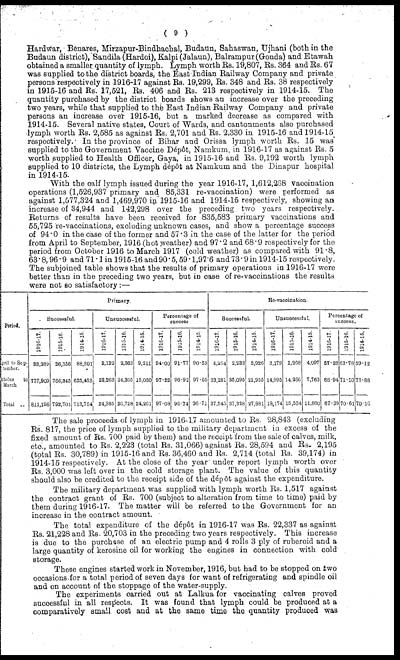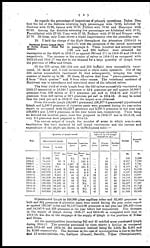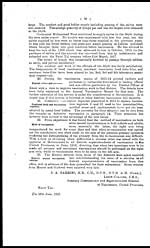Medicine - Vaccination > 1902-1928 - Report on vaccination in the United Provinces > Vaccination United Provinces of Agra and Oudh 1914-1922 > 1914-1917 - Triennial report on vaccination in the United Provinces of Agra and Oudh for the years 1914-15, 1915-16 and 1916-17
(156) Page 9
Download files
Individual page:
Thumbnail gallery: Grid view | List view

( 9 )
Hardwar, Benares, Mirzapur-Bindhachal, Budaun, Sahaswan, Ujhani (both in the
Budaun district), Sandila (Hardoi), Kalpi (Jalaun), Balrampur(Gonda) and Etawah
obtained a smaller quantity of lymph. Lymph worth Rs. 19,807, Rs. 364 and Rs. 67
was supplied to the district boards, the East Indian Railway Company and private
persons respectively in 1916-17 against Rs. 19,299, Rs. 348 and Rs. 38 respectively
in 1915-16 and Rs. 17,521, Rs. 406 and Rs. 213 respectively in 1914-15. The
quantity purchased by the district boards shows an increase over the preceding
two years, while that supplied to the East Indian Railway Company and private
persons an increase over 1915-16, but a marked decrease as compared with
1914-15. Several native states, Court of Wards, and cantonments also purchased
lymph worth Rs. 2,585 as against Rs. 2,701 and Rs. 2,330 in 1915-16 and 1914-15
respectively. In the province of Bihar and Orissa lymph worth Rs. 15 was
supplied to the Government Vaccine Dépôt, Namkum, in 1916-17 as against Rs. 5
worth supplied to Health Officer, Gaya, in 1915-16 and Rs. 9,192 worth lymph
supplied to 10 districts, the Lymph dépôt at Namkum and the Dinapur hospital
in 1914-15.
With the calf lymph issued during the year 1916-17, 1,612,268 vaccination
operations (1,526,937 primary and 85,331 re-vaccination) were performed as
against 1,577,324 and 1,469,970 in 1915-16 and 1914-15 respectively, showing an
increase of 34,944 and 142,298 over the preceding two years respectively.
Returns of results have been received for 835,583 primary vaccinations and
55,725 re-vaccinations, excluding unknown cases, and show a percentage success
of 94.0 in the case of the former and 57.3 in the case of the latter for the period
from April to September, 1916 (hot weather) and 97.2 and 68.9 respectively for the
period from October 1916 to March 1917 (cold weather) as compared with 91.8,
63.8, 96.9 and 71.1 in 1915-16 and 90.5, 59.1, 97.6 and 73.9 in 1914-15 respectively.
The subjoined table shows that the results of primary operations in 1916-17 were
better than in the preceding two years, but in case of re-vaccinations the results
were not so satisfactory :—
|
Period. |
Primary. |
Re-vaccination. |
||||||||||||||||
|
Successful. |
Unsuccessful. |
Percentage of |
Successful. |
Unsuccessful. |
Percentage of |
|||||||||||||
|
1916-17. |
1915-16. |
1914-15. |
1916-17. |
1915-16. |
1914-15. |
1916-17. |
1915-16. |
1914-15. |
1916-17. |
1915-16. |
1914-15. |
1916-17. |
1915-16. |
1914-15. |
1916-17. |
1915-16. |
1914-15. |
|
|
pril to Sep- |
83,289 |
26,356 |
88,301 |
2,122 |
2,363 |
9,211 |
94.00 |
91.77 |
90.55 |
4.264 |
2,233 |
5,926 |
3,179 |
1,268 |
4,097 |
57.28 |
63.78 |
59.12 |
|
ctobor to |
777,909 |
766,345 |
625,463 |
22,263 |
24,365 |
15,050 |
97.22 |
96.92 |
97.65 |
33,281 |
35,095 |
21,955 |
14,995 |
14,266 |
7,763 |
68.94 |
71.10 |
73.88 |
|
Total .. |
811,198 |
792,701 |
713,764 |
24,385 |
26,728 |
24,261 |
97.08 |
96.74 |
96.71 |
37,545 |
37,328 |
27,881 |
18,174 |
15,534 |
11,860 |
67.39 |
70.61 |
70.16 |
The sale proceeds of lymph in 1916-17 amounted to Rs. 28,843 (excluding
Rs. 817, the price of lymph supplied to the military department in excess of the
fixed amount of Rs. 700 paid by them) and the receipt from the sale of calves, milk,
etc., amounted to Rs. 2,223 (total Rs. 31,066) against Rs. 28,594 and Rs. 2,195
(total Rs. 30,789) in 1915-16 and Rs. 36,460 and Rs. 2,714 (total Rs. 39,174) in
1914-15 respectively. At the close of the year under report lymph worth over
Rs. 3,000 was left over in the cold storage plant. The value of this quantity
should also be credited to the receipt side of the dépôt against the expenditure.
The military department was supplied with lymph worth Rs. 1,517 against
the contract grant of Rs. 700 (subject to alteration from time to time) paid by
them during 1916-17. The matter will be referred to the Government for an
increase in the contract amount.
The total expenditure of the dépôt in 1916-17 was Rs. 22,337 as against
Rs. 21,228 and Rs. 20,703 in the preceding two years respectively. This increase
is due to the purchase of an electric pump and 4 rolls 3 ply of ruberoid and a
large quantity of kerosine oil for working the engines in connection with cold
storage.
These engines started work in November, 1916, but had to be stopped on two
occasions for a total period of seven days for want of refrigerating and spindle oil
and on account of the stoppage of the water-supply.
The experiments carried out at Lalkua for vaccinating calves proved
successful in all respects. It was found that lymph could be produced at a
comparatively small cost and at the same time the quantity produced was
Set display mode to: Large image | Zoom image | Transcription
Images and transcriptions on this page, including medium image downloads, may be used under the Creative Commons Attribution 4.0 International Licence unless otherwise stated. ![]()
| Permanent URL | https://digital.nls.uk/90473202 |
|---|
| Attribution and copyright: |
|
|---|




